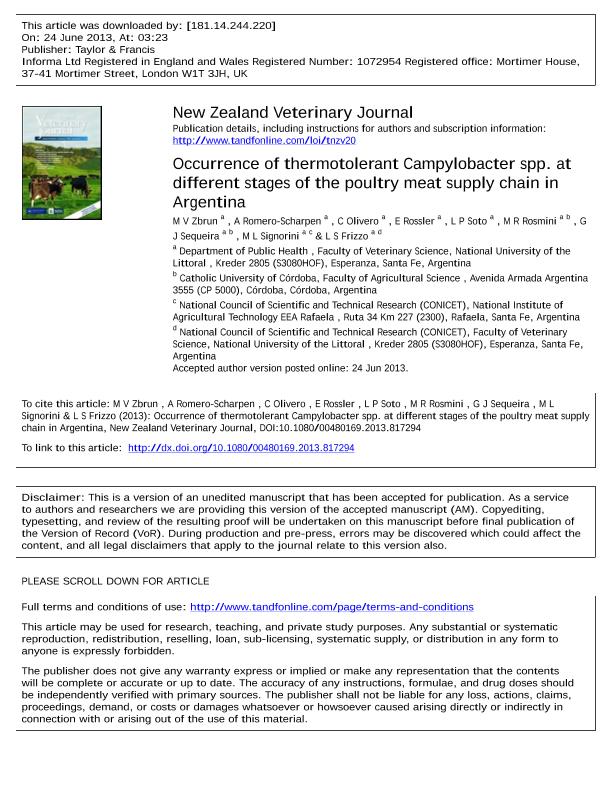Artículo
Occurrence of thermotolerant Campylobacter spp. at different stages of the poultry meat supply chain in Argentina
Zbrun, María Virginia ; Romero Scharpen, Analía
; Romero Scharpen, Analía ; Olivero, Carolina Raquel
; Olivero, Carolina Raquel ; Rossler, Eugenia
; Rossler, Eugenia ; Soto, Lorena Paola
; Soto, Lorena Paola ; Rosmini, M. R.; Sequeira, G. J.; Signorini, M. L.; Frizzo, Laureano Sebastian
; Rosmini, M. R.; Sequeira, G. J.; Signorini, M. L.; Frizzo, Laureano Sebastian
 ; Romero Scharpen, Analía
; Romero Scharpen, Analía ; Olivero, Carolina Raquel
; Olivero, Carolina Raquel ; Rossler, Eugenia
; Rossler, Eugenia ; Soto, Lorena Paola
; Soto, Lorena Paola ; Rosmini, M. R.; Sequeira, G. J.; Signorini, M. L.; Frizzo, Laureano Sebastian
; Rosmini, M. R.; Sequeira, G. J.; Signorini, M. L.; Frizzo, Laureano Sebastian
Fecha de publicación:
06/2013
Editorial:
New Zealand Veterinary Assoc Inc
Revista:
New Zealand Veterinary Journal
ISSN:
0048-0169
Idioma:
Inglés
Tipo de recurso:
Artículo publicado
Clasificación temática:
Resumen
AIMS: The objectives of this study were to investigate the occurrence and concentration of thermotolerant Campylobacter spp. at different stages of the poultrymeat supply chain in Argentina. METHODS: Three integrated poultry companies were sampled. Each supply chain was considered at different stages from the reproductive farm to chicken meat at a retail market. The stages sampled were: (a) hens from breeder flocks, (b) eggs in the incubator, (c) broiler chickens in flocks (aged <1 week and >5 weeks), (d) chickens at a slaughterhouse, and (e) chicken meat at a retail market. The chickens sampled along each supply chain were in the same batch. Samples collected were: (a) cloacal samples from hens and chickens on the farms, (b) fertile eggs, (c) feed, water and litter from flocks, (d) chicken carcasses from the slaughterhouse and retail market, and (e) caeca and livers from the slaughterhouse. Samples obtained were examined for Campylobacter spp. The isolates were biotyped and the genus and species identified by PCR. Campylobacter spp. on chicken carcasses at slaughterhouse and retail market were enumerated. RESULTS: The highest proportions of Campylobacter positive samples were observed in carcasses at retail (25/30, 83.3%) and faecal samples from breeding hens (27/45, 60.0%). Only 3.3% (3/ 90) samples collected from broiler chickens aged <1 week were positive, but the percentage of positive samples had risen to 28.9% (26/90) by the end of the rearing period. The proportions of Campylobacter positive carcasses and caecal contents at the slaughterhouse were both 33.3% (10 of 30 samples each). The concentration of Campylobacter contamination observed on carcasses at retail markets ranged from no bacteria/carcass to 3.71 log10 cfu/carcass. CONCLUSIONS: The data obtained provide essential information for future quantitative risk assessments aiming to estimate the probability of a person contracting campylobacteriosis following consumption of broiler meat in Argentina. CLINICAL RELEVANCE: The proportions of Campylobacterpositive samples found in this preliminary study indicate that a large proportion of the cases of human gastroenteritis in Argentina may be due to this pathogen. Human cases of gastroenteritis should be studied in greater detail and measures should be developed to reduce the proportion of poultry products that are contaminated by Campylobacterspecies..
Archivos asociados
Licencia
Identificadores
Colecciones
Articulos(CCT - SANTA FE)
Articulos de CTRO.CIENTIFICO TECNOL.CONICET - SANTA FE
Articulos de CTRO.CIENTIFICO TECNOL.CONICET - SANTA FE
Articulos(ICIVET-LITORAL)
Articulos de INST. DE CIENCIAS VETERINARIAS DEL LITORAL
Articulos de INST. DE CIENCIAS VETERINARIAS DEL LITORAL
Citación
Zbrun, María Virginia; Romero Scharpen, Analía; Olivero, Carolina Raquel; Rossler, Eugenia; Soto, Lorena Paola; et al.; Occurrence of thermotolerant Campylobacter spp. at different stages of the poultry meat supply chain in Argentina; New Zealand Veterinary Assoc Inc; New Zealand Veterinary Journal; 61; 6; 6-2013; 337-343
Compartir
Altmétricas



